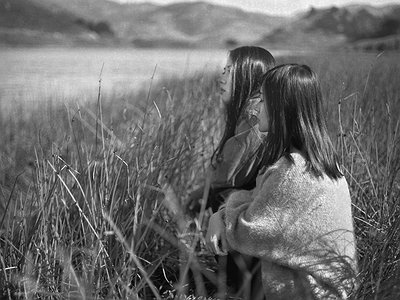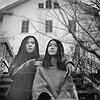Part 2
Take us through a day in your life, from a possible morning routine through to your work, please. Do you have a fixed schedule? How do music and other aspects of your life feed back into each other - do you separate them or instead try to make them blend seamlessly?
Lemon: We began making 42 Days during our duo artist residency at the Headlands Center for the Arts, which is a former military site surrounded by gorgeous northern California wilderness. Almost every day, we took long walks, encountering owls, coyotes, eucalyptus trees, ships, and the ocean. And we spent a lot of time improvising on pipa and voice, really getting to know each other’s instruments. The album was directly influenced by those daily routines. But when I’m on my own in New York, I usually don’t have a fixed schedule. My current time zone is probably somewhere in the middle of the Pacific Ocean.
Sophia: My daily routine will bore you to tears. The first thing I do every day is to wander into the kitchen and make coffee - no matter where I am, at home or at a residency. And then I’ll wake up for a few minutes and start practicing pipa and piano, or compose, depending on the mood. I teach four days a week, so on those days I wrap up my practice around noon and start teaching like a maniac straight till the evening. On the days I don’t teach, I tend to have the energy to do more creative works. For example, when we were making the album 42 Days, I would work my arse off on my off days and then count on Lemon’s magic and disappear into sending “puppy getting haircut” videos.
Can you talk about a breakthrough work, event or performance in your career? Why does it feel special to you? When, why and how did you start working on it, what were some of the motivations and ideas behind it?
Sophia: I don’t think I’ve had a breakthrough work yet. I had works and performances that I was more satisfied with than others, but still don’t know what a breakthrough feels like. Although I feel like every day I’m learning and growing. I’m content with that for now.
Lemon: “Day 22: Luminescence” from 42 Days was a breakthrough for me, not career-wise, but in terms of overcoming creative blocks. I have to thank the huge empty space that the Headlands gave Sophia and me as our studio at the time. It was so liberating to sing as loud as I wanted, feeling my voice bounce off the walls, without worrying about disturbing anyone. Turns out space matters. Loudness really matters. It helped lift some huge weight I had carried in my voice and let “Luminescence” flow out. It made me realize that I had been making music in my tiny bedroom for so long, with stressed neighbors who were only a thin wall away, that I was constantly worried about being too loud and became a much quieter singer. It was killing my musical impulses. Musicians who live in apartments or have roommates can probably relate to this.
There are many descriptions of the ideal state of mind for being creative. What is it like for you? What supports this ideal state of mind and what are distractions? Are there strategies to enter into this state more easily?
Sophia: I always thought that the ideal state of mind to create is when I’m distraction-free, but life constantly disagrees with that. Sometimes deadlines and hectic schedules actually make me more productive. So I learned that there’s no ideal state of mind and you can’t wait for that. Different states of minds will contribute to different results of the work you’re doing. You just have to seize the seconds you’ve got to create.
Music and sounds can heal, but they can also hurt. Do you personally have experiences with either or both of these? Where do you personally see the biggest need and potential for music as a tool for healing?
Sophia: I’ve been to shows or concerts where I could barely sit through, but that is more of a taste issue. What’s unenjoyable to me might be delightful to others, and that’s what I like a lot about music, the diversity.
There is a fine line between cultural exchange and appropriation. What are your thoughts on the limits of copying, using cultural signs and symbols and the cultural/social/gender specificity of art?
Sophia: In the past there were a few times when a composer approached me and asked if I could just play d minor chord or make certain sounds on pipa without having real interest in learning about this instrument or the aesthetics of the music. To me that’s borderline appropriation. I think being open-minded and humble is the key to successful cultural exchange.
Our sense of hearing shares intriguing connections to other senses. From your experience, what are some of the most inspiring overlaps between different senses - and what do they tell us about the way our senses work?
Lemon: I always feel hungry after playing or experiencing a good show. I think my gut is very receptive to sound.
Art can be a purpose in its own right, but it can also directly feed back into everyday life, take on a social and political role and lead to more engagement. Can you describe your approach to art and being an artist?
Lemon: The works of Southeast of Rain are connected to the environment. In some way, 42 Days is an attempt at reimagining the relationship between humans and our environments, not so much as a duality, but something more porous and fluid.
Also, our work doesn’t fit neatly into genres typically reserved for musicians who play traditional instruments. I think there is value in this resistance to pigeonholing.
What can music express about life and death which words alone may not?
Lemon: Speaking for myself, as someone who has been struggling to put words in my work, I feel like music doesn’t have as much pressure to make sense, neither does life.






